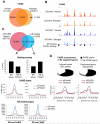FOXA1 is a key determinant of estrogen receptor function and endocrine response
- PMID: 21151129
- PMCID: PMC3024537
- DOI: 10.1038/ng.730
FOXA1 is a key determinant of estrogen receptor function and endocrine response
Abstract
Estrogen receptor-α (ER) is the key feature of most breast cancers and binding of ER to the genome correlates with expression of the Forkhead protein FOXA1 (also called HNF3α). Here we show that FOXA1 is a key determinant that can influence differential interactions between ER and chromatin. Almost all ER-chromatin interactions and gene expression changes depended on the presence of FOXA1 and FOXA1 influenced genome-wide chromatin accessibility. Furthermore, we found that CTCF was an upstream negative regulator of FOXA1-chromatin interactions. In estrogen-responsive breast cancer cells, the dependency on FOXA1 for tamoxifen-ER activity was absolute; in tamoxifen-resistant cells, ER binding was independent of ligand but depended on FOXA1. Expression of FOXA1 in non-breast cancer cells can alter ER binding and function. As such, FOXA1 is a major determinant of estrogen-ER activity and endocrine response in breast cancer cells.
Figures






Comment in
-
Determination of transcription factor binding.Nat Genet. 2011 Jan;43(1):11-2. doi: 10.1038/ng0111-11. Nat Genet. 2011. PMID: 21217639 No abstract available.
References
-
- Ali S, Coombes RC. Endocrine-responsive breast cancer and strategies for combating resistance. Nat Rev Cancer. 2002;2:101–12. - PubMed
-
- Clarke R, Leonessa F, Welch JN, Skaar TC. Cellular and molecular pharmacology of antiestrogen action and resistance. Pharmacol Rev. 2001;53:25–71. - PubMed
-
- Glass CK, Rosenfeld MG. The coregulator exchange in transcriptional functions of nuclear receptors. Genes Dev. 2000;14:121–41. - PubMed
Publication types
MeSH terms
Substances
Associated data
- Actions
Grants and funding
LinkOut - more resources
Full Text Sources
Other Literature Sources
Molecular Biology Databases
Research Materials

